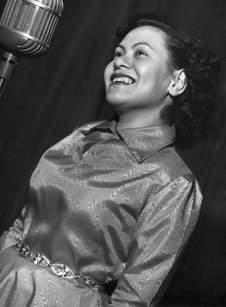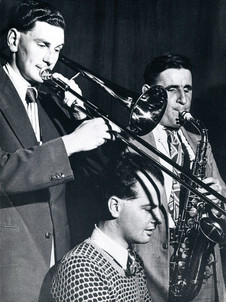The words have written themselves into the history of great New Zealand phrases alongside All Black Peter Jones’s comment broadcast live after a 1956 Springbok test (“I’m absolutely buggered”), or prime minister Jim Bolger’s dismissive words after the 1993 general election: “Bugger the pollsters.”
For those there on the night of 7 August 1950, Peter Young’s first words through the microphone in the Auckland Town Hall Concert Chamber rang with off-the-cuff resonance.
Young – as compere of what is regarded as Auckland’s “first jazz concert” – as opposed to dance music – stepped onto the small stage that night and immediately observed: “Those bloody lights are on.”
In a metaphorical way, he was also right: jazz as a serious listening experience was under the spotlight.

Mavis Rivers at the concert, 7 August, 1950 - Ref: PAColl-6388-13. Alexander Turnbull Library, Wellington, New Zealand
Jazz, a music much derided for its freedom from constraint and slightly seedy image, had come uptown from the nightclubs and dancehalls. Among its practitioners on this night were saxophonist Julian Lee, pianist Crombie Murdoch, trumpeter Murray Tanner, singer Mavis Rivers and others who would become mainstays of the music in this country and overseas.
It would take a long memory or diligent research to get a complete picture of what it must have been like that August night, but with the rediscovery of the original tapes in the early 1990s – recorded direct to acetate by Noel Peach from a Post Office landline down Queen St to the 1YA radio studios in Shortland Street – the music of that period came back fresh and clear.
And there were some reviews of the concert which give voice to how the music was received at the time.
The New Zealand Herald allowed a number of column inches (that was the standard measure) to a piece by DFT who, from the comment and tone, seemed to be more of the classical persuasion.
“Being unused to jazz except as a background I found it hard to tell one tune from another, capricious or otherwise. It didn’t matter because the variations were the interesting part”.
DFT did note however the enthusiasm and number in attendance: “Jam-packed is the only way to describe the Town Hall concert chamber last night”. And how youthful the audience was.

Auckland's Premier Jazz Concert, Auckland Town Hall Concert Chamber, 7 August 1950. - Auckland War Memorial Museum, EPH-PT-15-1_001
From this distance the review can be unintentionally amusing, especially when the Herald’s man – and we can safely guess the reviewer was male – says he spoke to “a foreign expert from the country where they know about such things”.
DFT is assured these musicians were the best in the country.
In the October edition of the Australian Music Maker there was also a review, by Bert Peterson, musician, columnist, and executive of the Auckland Musicians Union. He acclaimed the event as “a sensational success” with “hundreds turned away”.
“Judging by the reception given to the performers we are bound to be treated to many more jazz concerts, and the more the better as far as I am concerned.”
In 1994, 44 years after that historic event, Young’s opening words rang out again on recently discovered tapes of this ambitious event which introduced jazz as a serious music.
The show had been organised and promoted by drummer Bruce MacDonald who pulled it together in just six weeks, yet the musicianship was of a remarkably high standard, as evident on the tapes.
Errol Baker, jazz researcher and radio presenter who assisted 1ZB’s Jim Sutton in the research and re-presentation of these recordings noted, “New Zealand jazz musicians were amazingly inventive in this period because there had been a lot of American jazz heard here during the war through Voice of America or Armed Forces Radio.
“Sheet music took ages to get here and, of course, this was just after the war so there were not that many recordings around. Shellac used to make records had been put into the war effort.
“New Zealand musicians were dependent on listening and then using their own skills, so we shouldn’t be surprised at the standard of musicianship.”
The trail of recovery of this music – reissued later on CD, but disappointingly with Young’s initial comment edited out – began in 1990 when Sutton discovered two old boxes of tapes in the late Peach’s garage, one of which had “jazz concert” written on it.

Dale Alderton, Crombie Murdoch, Julian Lee. - Stebbing archive
Inside were brittle tapes with little attendant information other than some song titles and the names of musicians such as Lee, Murdoch, and Rivers.
In 1993 Sutton, Baker and others began the process of recovering the music. Information was gathered from the United States on how to dehumidify the tapes to prevent them from falling apart, on the transfer to DAT (digital audio tape) and then looking to put names to the players.
Baker says it was a jigsaw puzzle of leads that initially went nowhere. Artists who were there were unable to recall who else had played. But then there was the chance discovery of a programme from the night, and the putting of names to faces from a Weekly News photo-spread of the concert.
Reviews of the period, as we have seen, were only helpful in small ways. Fortunately, standards of criticism and the more educated ear of today’s audience, jazz or otherwise, allows contemporary listeners to isolate the various styles and artists in a more rewarding way.
In a lengthy article in the NZ Listener in 1994, Duncan Campbell backgrounded the discovery and retrieval of the tapes and also addressed some of the players specifically: pianist Crombie Murdoch “is a revelation flashing right-hand filagree that would rival Thelonious Monk”; guitarist Mark Kahi “demonstrated a technique that owes much to Polynesia” and Mavis Rivers is “sweet and beguiling”.
According to Murdoch however, the man who stole the show was tin whistle player Hughie Gordon who, although he couldn’t read music and learned from his father, invited comparisons “with clarinettists Benny Goodman and Artie Shaw for sheer dexterity,” wrote Campbell.
The drummer Bruce Morley also wrote a substantial article on the recordings for Music in New Zealand, noting “there’s a real feeling of excitement on this album (something often missing on some of today’s fashionably retro albums).”
He did however say that comparing Murdoch with the inventive bebop giant Monk was a stretch. Murdoch was, wrote Morley, “an incurable romantic, a trait that spills out in his wonderful piano playing”.
Multi-instrumentalist Julian Lee later said, “we weren’t as good as we thought we were”. Musicians can often be unkindly self-critical.
To get a clear perspective we go back to the tapes themselves.
After announcer Young’s observation about the lights, he offered the first of his informed, humorous but somewhat cringe-inducing introductions to the music to be played, noting that the musicians are out to debunk the pre-conception that jazz is associated with dancing.
They are out to present “the creative side of jazz” to the public.
Young explains that this is music to be listened to and that “the musicians will take the tune, the group gives the first chorus a workout, then it’s over to the soloist to weave a pattern around, but still in harmony with the original”.
The solos are entirely spontaneous, he notes, and the musicians can improvise freely.
The preamble aside, Young introduces the first tune “which has been arranged by Julian Lee and the Burroughs Adding Company … ‘Baby You Can Count On Me’.” Groan.
During ‘Baby You Can Count On Me’ pianist Crombie Murdoch plays a hard-hitting solo full of falling cascades of notes
The swinging arrangement which follows, letting pianist Murdoch play a hard-hitting solo full of falling cascades of notes, is typical of the music the night offered: swing-orientated, full of rich melodic flourishes and graced by the presence of Rivers who sang ‘I Can’t Get Started’, ‘How High the Moon’, ‘Dedicated to You’ and ‘Boogie Blues’.
Two of the tracks are particularly fascinating – ‘Sweet Sue’ and ‘Lady Be Good’ feature that rarest of instruments in jazz, the tin whistle (“worth sixpence” said Errol Baker) played by Gordon.
Judging by the response to these tunes, ‘Swinging the Blues’, Duke Ellington’s ‘Caravan’ and others of the 21 tracks, this was a night hugely enjoyed by the capacity audience.
They had paid 3/6d a ticket (although hundreds were turned away, many offering 10/- to fortunate ticket holders, wrote Peterson in the Australian Music Maker). And the historic value of of this concert should be under-scored.
The musicians included some of the finest artists this country has produced: pianist Julian Lee established a reputation for himself in the United States where he became an arranger at Capitol Records, Mavis Rivers won plaudits from the likes of Frank Sinatra during her long residency in California, and players such as Murray Tanner and Mark Kahi became local heroes.
On the cover of the programme there was a quote from the American poet Walt Whitman.
“Hark, some wild trumpeter, some strange musician,
Hovering unseen in air, vibrates capricious tunes tonight”
The 1994 tapes were, years later, digitally remastered by Stebbing Recording Studios engineer Steve McGough, and released on CD by Ode in 2012. To have available again music of such good technical quality can take the listener right back to that stuffy room to feel an energy and sense of occasion that is almost palpable.
As the New Zealand Herald review of the following day noted, in the moderate tone of the period: “… had Ellington, Dorsey or Goodman chanced by the Auckland Town Hall last night they might have paused, listened and muttered – ‘not bad’.”
--
Expanded by Graham Reid from an article which originally appeared on his website Elsewhere.